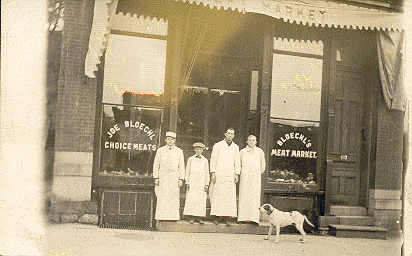THE MONTHLY HIGHHOLDER
March 2003
Vol. 2, Issue 3
| HIGHHOLDER FAMILY TREE
Remember to submit your information for the Highholder family tree.
Currently we have over 3000 individuals in the tree. Don't be left out. Send
your information to: Bob Ziemba rlzaez@charter.net .
See the December Monthly Highholder for more information. |
|
New information on the HUNGARY page.
|
| Oshkosh Daily Northwestern
June 26, 1953 Bloechl Meat Market Started Here in 1899 Store is one of oldest of type in Oshkosh The Bloechl Meat Market, one of the oldest establishments of meat dealers in the City of Oshkosh, was established in 1899 by John Bloechl, who came here from Chicago, and Louis Putz. The concern, known as the Bloechl and Putz Market, was located at 1043 Fifth St., and the business has been carried on at the same address ever since. Mr. Putz withdrew from the business in 1914, after which it was operated by Mr. Bloechl alone. The latter's son. Louis Bloechl, entered the business in 1919, and became the owner when the senior Mr. Bloechl died. The Southside concern is another of this city's many "third generation" firms, Louis Bloechl's sons having started in the meat business almost as soon as they could safely "handle a cleaver." photo of John and his son, Louis, delivering meat in a horse-drawn wagon Still Active in Market Louis Bloechl is still active in the meat market, although the business management is handled by Clarence Bloechl, his son. Another son, Eugene Bloechl, is also associated with the firm, as is a grandson-in-law. Meat market operations have changed a good bit since the earlier days. Meat was chopped in those years by means of what was known as a "hand rocker," a device which, as its name would indicate, was rocked back and forth by hand until the meat had taken on the required texture. Bloechl's first meat grinder was operated by gasoline. There were no chicken "pickers" in those days. When the holidays rolled around, neighbor women were glad to pitch in at "picking bees." They kept the feathers using them to make into pillows and feather ticks. Lambs and sheep were also handled by neighbors. The women took the wool, washed and dried it, sent it out for carding and made into quilts. Old-fashioned sausages were made by hand. There were no such things as automatic stuffers. Sausages were stuffed, instead, by means of a funnel-shaped steer horn. Nor were there streamlined refrigeration mechanisms in those days. Several times each week the iceman visited the meat market to fill up the huge ice box. Tools were kept sharp by hand, and the showcase was made of wood and was scrubbed inside and out every week. The floor was covered with sawdust instead of with tile. Huge barrels of homemade sauerkraut and herring were kept on hand. Once a week, lard was rendered out in a big cast iron kettle. Before the lard had cooled, the neighbors would come in for "scraps." Thanks to Bernice Robl Bloechl for a copy of this story. ****************** Comments by Bernice Robl Bloechl The meat market continued operation under Erwin's Grandfather Louis, then Erwin's father George, until about 1969, when the "Mom and Pop" stores faded out. They did business on the same corner for 70 years. Across the street was the Berger Grocery Store, owned and run by Louis's sisters, Mary Bloechl Berger and Ann Bloechl Kellerman. The Bloechl's come from a long line of butchers. They also settled in Chicago.
|

This picture was offered for sale on Ebay, January 2003. It is a picture of Bloechl's Meat Market. I think it is located in Chicago. The people are not known.
|
|
German Youth Bund A program from the May 1902 Meeting in Oshkosh 8th General Assembly of the German Catholic Youth Bund Many names with pictures, great ads, 88 pages. Thanks to Marion Schmid and Charles Nigl for a copy of this program. Charles has also donated a copy to the Oshkosh Public Library so you can see it for yourself. sample page Pictured Johann Freidl. Franz Esslinger, Josef Herrle, Franz Kloiber, Albert Jungwirth, August Brelwick Jos. Wiener, Simon Binder, Max Weishaupl Ads for places such as: Steckbauer Sample Room, Nigl Groceries, Blechl and Putz Meats, Fenzl
Tavern, |